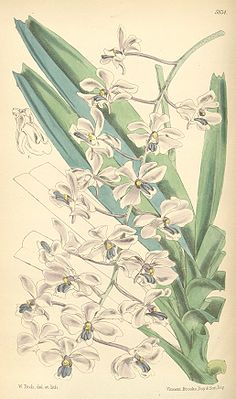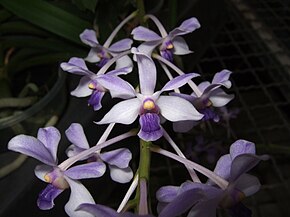Vanda coerulescens
| Vanda coerulescens | ||||||||||||
|---|---|---|---|---|---|---|---|---|---|---|---|---|

Vanda coerulescens |
||||||||||||
| Systematics | ||||||||||||
|
||||||||||||
| Scientific name | ||||||||||||
| Vanda coerulescens | ||||||||||||
| Handle. |
The orchid Vanda coerulescens is an epiphytic growing plant from Southeast Asia. It is occasionally used as an ornamental plant.
description
Vanda coerulescens grows as a monopodial epiphyte . The shoot reaches a length of 2 to 8 cm, according to other information also up to 10 or 15 cm, with a diameter of 1 to 1.5 cm. The two-line, fleshy leaves are 7 to 12 cm (up to 25 cm) long and 1 to 1.8 cm wide. The tip is cut irregularly and serrated.
In March to April, one or two inflorescences appear each from a leaf axil, they stand horizontally or hang down. The inflorescence axis is 14 to 36 cm (up to 50 cm) long, 10 to 16 flowers are in the front half. The oval-triangular bracts are 1.5 to 3 mm in size. Pedicel and ovary are bluish white and measure 1.5 cm to third The flowers are paper-like, thin, light blue, they open wide, their diameter is 1.5 to 3.5 cm. The sepals are inverted egg-shaped to spatulate, 1 to 1.7 cm long and 0.6 to 0.8 cm wide, tapering at the base in a wedge shape. The petals are similarly shaped, but slightly narrower. The lip is dark blue and has a curved, cylindrically shaped, blunt-ended spur at the base. The side lobes of the three-lobed lip stand upright and are light blue. The end of the middle lobe is rounded and slightly drawn in. There are three to five longitudinal keels on the lip. The blue column is 0.5 to 0.7 cm long, with a light yellow stamen .
The number of chromosomes is 2n = 38 or 2n = 40.
distribution
Vanda coerulescens is native to Southeast Asia, its range extends over northeast India, the south of the Chinese province of Yunnan, Myanmar and the north of Thailand. It occurs at altitudes of 300 to 500 meters (up to 1600 meters). It grows as an epiphyte on tree trunks in open forests.
Systematics and botanical history
Vanda coerulescens was found in Burma (Myanmar) by William Griffith in 1837 , he published the first description in 1851. General Benson first sent live plants in 1868 to the English nursery Veitch and Sons .
Three varieties have been described: var. Boxallii , var. Hennisiana, and var. Lowiana , but they are all considered synonyms of the type.
supporting documents
- ↑ a b c d e f g Alexandra Bell, Xinqi Chen: Vanda . In: Wu Zhengyi, Peter H. Raven (Ed.): Flora of China . tape 25 . Missouri Botanical Garden Press, St. Louis 2009, pp. 472 ( efloras.org ).
- ↑ a b c d e H. Bechtel, Ph. Cribb, E. Launert: Orchideenatlas . 3. Edition. Ulmer, Stuttgart 1993, ISBN 3-8001-6199-0 , p. 449 .
- ↑ a b c FG Brieger, R. Maatsch, K. Senghas (eds.): Rudolf Schlechter: Die Orchideen . 3. Edition. Volume I / B. Paul Parey, 1992, ISBN 3-489-78622-X , p. 1217 .
- ↑ a b Rafaël Govaerts (ed.): Vanda coerulescens. In: World Checklist of Selected Plant Families (WCSP) - The Board of Trustees of the Royal Botanic Gardens, Kew .
